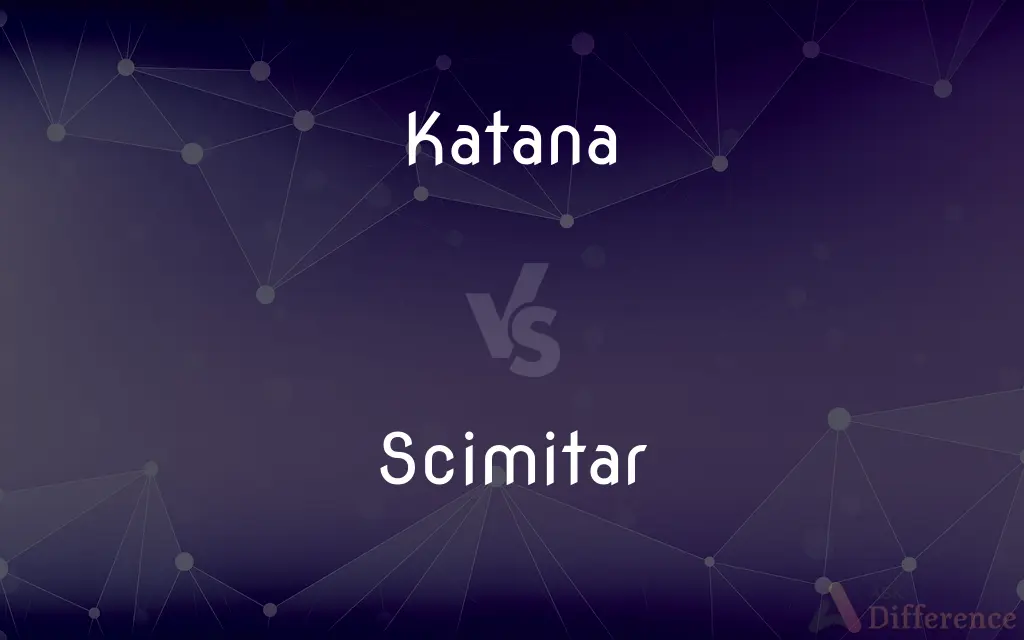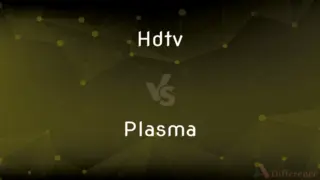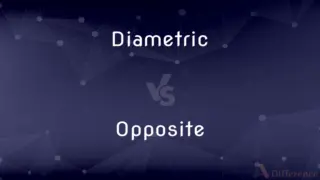Katana vs. Scimitar — What's the Difference?
Edited by Tayyaba Rehman — By Urooj Arif — Updated on April 16, 2024
Katana features a curved, slender, single-edged blade with a circular or squared guard, used primarily in Japan; scimitar boasts a more pronounced curve and is often broader, favored in the Middle East.

Difference Between Katana and Scimitar
Table of Contents
ADVERTISEMENT
Key Differences
A katana is a traditional Japanese sword known for its distinctive appearance, which includes a curved, single-edged blade, circular or squared guard, and long grip to accommodate two hands. Whereas, the scimitar is a type of sword that features a more pronounced curve and is typically broader, used traditionally in the Middle East and South Asia.
The katana's blade is crafted to allow for precise cutting and slashing, an essential aspect of samurai warfare and martial arts. On the other hand, the scimitar’s design focuses on speed and the ability to deliver powerful slashes, making it a favored weapon in cavalry charges and close combat.
In terms of construction, the katana is known for its meticulous forging process that involves folding the steel multiple times to create a strong, sharp edge. In contrast, scimitars are often made from a single piece of steel, which contributes to a quicker production process but less intricate detailing.
Historically, the katana is deeply embedded in Japanese culture and history, symbolizing the samurai’s honor and the martial virtues of feudal Japan. Whereas the scimitar is often associated with the Persian warriors and has become a symbol of Middle Eastern heritage and the Islamic conquests.
Aesthetically, katanas often feature ornate decorations on their hilts and are part of traditional attire in various Japanese ceremonies. The scimitar, meanwhile, sometimes features a crossguard that flares out to protect the hand, with decorations that reflect Middle Eastern artistry.
ADVERTISEMENT
Comparison Chart
Origin
Japan
Middle East/South Asia
Blade Shape
Curved, slender, single-edged
More pronounced curve, often broader
Usage
Cutting, slashing
Slashing, powerful cuts
Historical Significance
Symbol of samurai honor, Japanese culture
Associated with Persian warriors, Islamic conquests
Aesthetic Characteristics
Often ornate, with decorated hilts
May feature flared crossguard and regional artistry
Compare with Definitions
Katana
A traditional Japanese sword with a curved blade.
The samurai unsheathed his katana, ready for battle.
Scimitar
Appears in various cultural representations.
The scimitar was prominently featured in the film about ancient Persia.
Katana
Featured in many historical and cultural exhibitions.
The museum’s exhibit on katanas attracted history enthusiasts.
Scimitar
Designed for swift, powerful strikes.
His scimitar moved swiftly, cutting through the air.
Katana
Known for its sharp edge and two-handed grip.
He admired the katana’s sharp edge, ideal for slicing.
Scimitar
Often used by cavalry.
The cavalrymen were equipped with scimitars for the charge.
Katana
Part of martial arts equipment.
The dojo displayed several katanas used in training.
Scimitar
A broad, curved sword from the Middle East.
The warrior wielded a scimitar in each hand.
Katana
Symbolic in Japanese culture.
The katana at the ceremony symbolized honor and valor.
Scimitar
Symbolic in Islamic and Middle Eastern heritage.
The scimitar represents strength in many Middle Eastern cultures.
Katana
A katana (刀 or かたな) is a Japanese sword characterized by a curved, single-edged blade with a circular or squared guard and long grip to accommodate two hands. Developed later than the tachi, it was used by samurai in feudal Japan and worn with the blade facing upward.
Scimitar
A scimitar ( or ) is a backsword or sabre with a curved blade typically associated with Middle Eastern, South Asian, or North African cultures.
Katana
A long, single-edge sword for use with two hands, traditionally worn by samurai.
Scimitar
A curved Asian sword with the edge on the convex side.
Katana
A type of Japanese longsword or tr=nihontō, having a single edge and slight curvature, historically used by samurai and ninja.
Scimitar
A sword of Persian origin that features a curved blade.
Scimitar
A long-handled billhook.
Scimitar
(transitive) To strike or slice with, or as if with, a scimitar.
Scimitar
A curved oriental saber; the edge is on the convex side of the blade
Common Curiosities
What makes the scimitar distinct in its design?
The scimitar is distinguished by its broad and significantly curved blade.
What type of combat is the scimitar best suited for?
The scimitar is best suited for swift, slashing attacks, often from horseback.
Can a katana be used with one hand?
While it can be used with one hand, the katana is generally designed for two-handed use.
What historical figures are most associated with the scimitar?
Historical figures like the Persian warriors and Islamic cavalrymen are often associated with the scimitar.
What is the cultural significance of a katana in Japan?
In Japan, the katana is a symbol of the samurai's honor and the virtues of bushido.
Is the katana used in modern martial arts?
Yes, the katana is widely used in modern martial arts, including kendo and iaido.
How does the weight of a scimitar compare to a katana?
Scimitars are generally lighter than katanas, facilitating quick, agile movements.
Are scimitars still made traditionally today?
Traditional methods are still used, but many scimitars are now produced using modern techniques.
What is the primary use of a katana?
The katana is primarily used for cutting and slashing in a martial context.
How is a katana traditionally made?
A katana is traditionally made by repeatedly folding and forging the steel, creating a strong, sharp blade.
What materials are used in the handle of a katana?
Katana handles are typically wrapped in ray skin and silk or cotton cord for a secure grip.
What role does the scimitar play in Middle Eastern dance?
The scimitar is often used as a prop in traditional Middle Eastern dances to depict historical or mythical narratives.
Share Your Discovery

Previous Comparison
HDTV vs. Plasma
Next Comparison
Diametric vs. OppositeAuthor Spotlight
Written by
Urooj ArifUrooj is a skilled content writer at Ask Difference, known for her exceptional ability to simplify complex topics into engaging and informative content. With a passion for research and a flair for clear, concise writing, she consistently delivers articles that resonate with our diverse audience.
Edited by
Tayyaba RehmanTayyaba Rehman is a distinguished writer, currently serving as a primary contributor to askdifference.com. As a researcher in semantics and etymology, Tayyaba's passion for the complexity of languages and their distinctions has found a perfect home on the platform. Tayyaba delves into the intricacies of language, distinguishing between commonly confused words and phrases, thereby providing clarity for readers worldwide.
















































